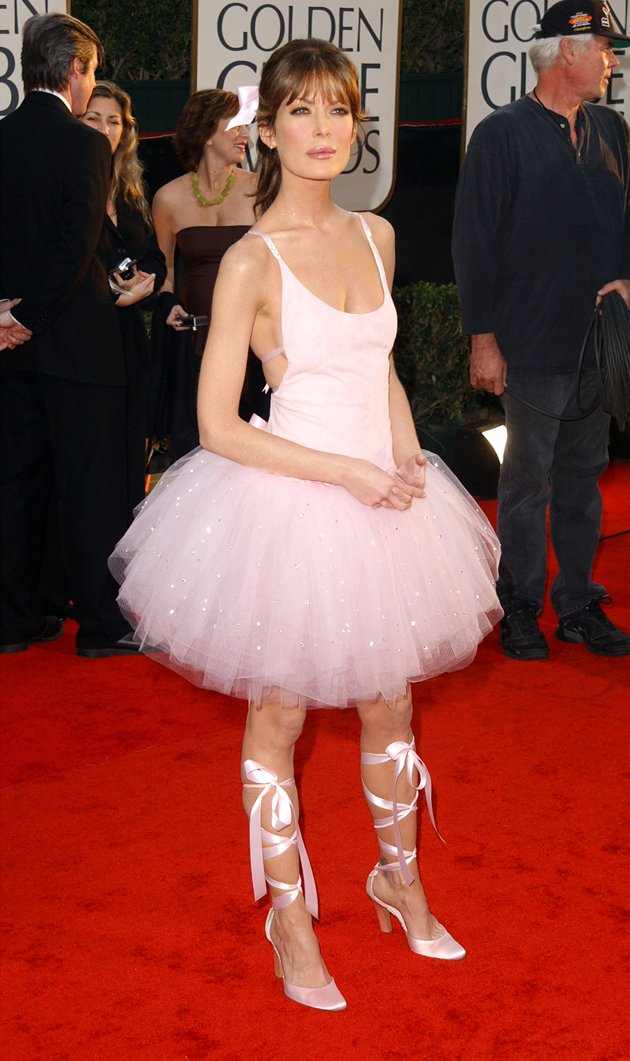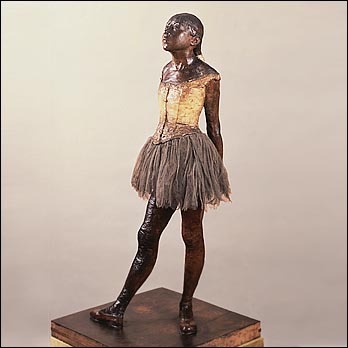Dance and fashion: I missed this…
…back in 2003 when acturess Lara Flynn Boyle wore it.
But some looks are simply timeless, and so I’m moved to share it with you:
Why, oh why, oh why, do so many beautiful women celebrities (or celebrity-seekers) try so very hard to look different that they only succeed in making themselves look silly?
Here’s the inspiration, though:
Degas’ sculpture of a young dancer impressed me mightily the first time I saw it, many many years ago, as do all his dancers. Ballet dancers are common subjects for artists, but it’s also common for the painter or sculptor to get the poses and attitudes wrong. Degas always got it exactly right.
This is how dancers still stand when in repose. The curve of the young girl’s leg is somewhat hyperextended in just the way dance training encourages, and her left ankle is “rolling in” slightly in the way young dancers often relax. In art history class in college I was told what an amazingly accurate observer Degas was; this was in connection with his horse racing paintings where he was able to see (aided by photography) that there is an instant in which all four of the horse’s legs are off the ground. But to me, his observations of dancers are even more astounding. No other artist has even come close.



Neo: I agree with you re Degas. There is some about the way dancers hold themselves and move — even while walking — that is immediately identifiable. Something about poise, lightness and grace that I can’t really describe (but want to say that “I know it when I see it”); Degas almost always captures this in his paintings and drawings and he certainly does so with this sculpture.
BTW, one can usually spot swimmers too, but with them it’s always the shoulders that give them away…
If I remember correctly (which is chancy, because I don’t pay much attention to celebrities in the first place) this was a dig at Clint Eastwood for his affair with a ballerina.
Probably has something to do with my advanced age, but to me there is nothing more attractive (sexy in the current vernacular) than a woman who dresses in understated, but stylish fashion.
A lot of the current dresses on the red carpet seem to be modeled after ice dancing costumes – ‘lotsa illusion netting, sparkles and sheer fabrics.
Is hyperextension taught, or orthopedically encouraged?
Richard Aubrey: not exactly either one.
Hyperextension is something many dancers have some degree of naturally, in the first place. It tends to go along with being flexible. And then ballet training encourages further hyperextension of the knee, not as a desirable trait in itself, but simply as a consequence of the type of stretches and exercises that go to make a dancer.
When I was being trained, hyperextension was frowned upon. To the degree people could, they were taught to become aware of it and not to encourage and exaggerate it; the idea was to not forcibly lock the knee past the 180-degree line. Nowadays I’ve noticed it seems to be more common to have an extreme degree of hyperextension, I think because of the more exaggerated line that is considered beautiful in ballet these days, but in former years was considered distortion and gymnastics or “circus tricks” rather than art, as well as setting the dancer up for injury.
Here is an article (with a photo) on how teachers can help dancers control hyperextension. And here is an article of mine where I discuss the issue of the sort of extreme lines that are favored in ballet these days.
For a while, forty-plus years ago, I hung out with a woman who had “reverse knee lock”, which is natural hyperextension, and she said it was useful in the dance experience.
In my limited dance experience–knee locks up when the music starts although I did manage to dance with my daughter at her wedding–I prefer a straight line instead of something that looks like what happens when you get hit from the wrong direction. And that was before I coached soccer for girls of 12-13, when I had five knee injuries in one season, which is five more than I had in the other five seasons combined.
Ought to be illegal, as well as being ungraceful.
But, if some is good, more is better and there’s always competition.
Lara Flynn Boyle was hot until she got the duck lip implants around season 5 of “The Practice”